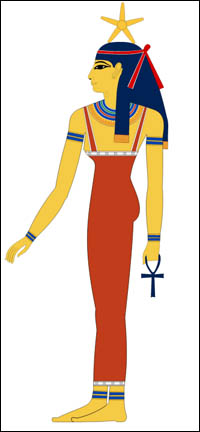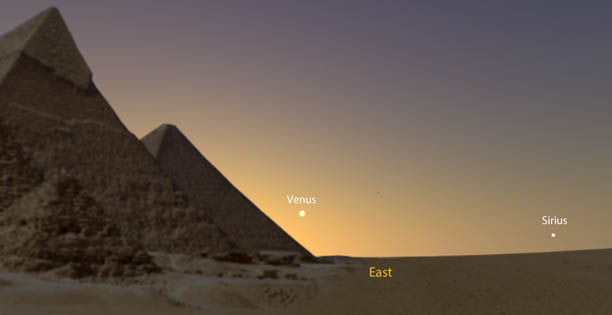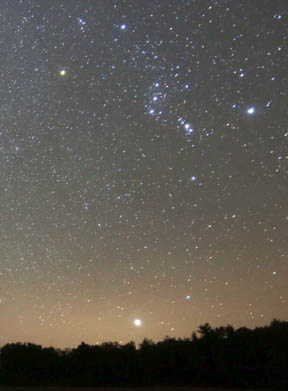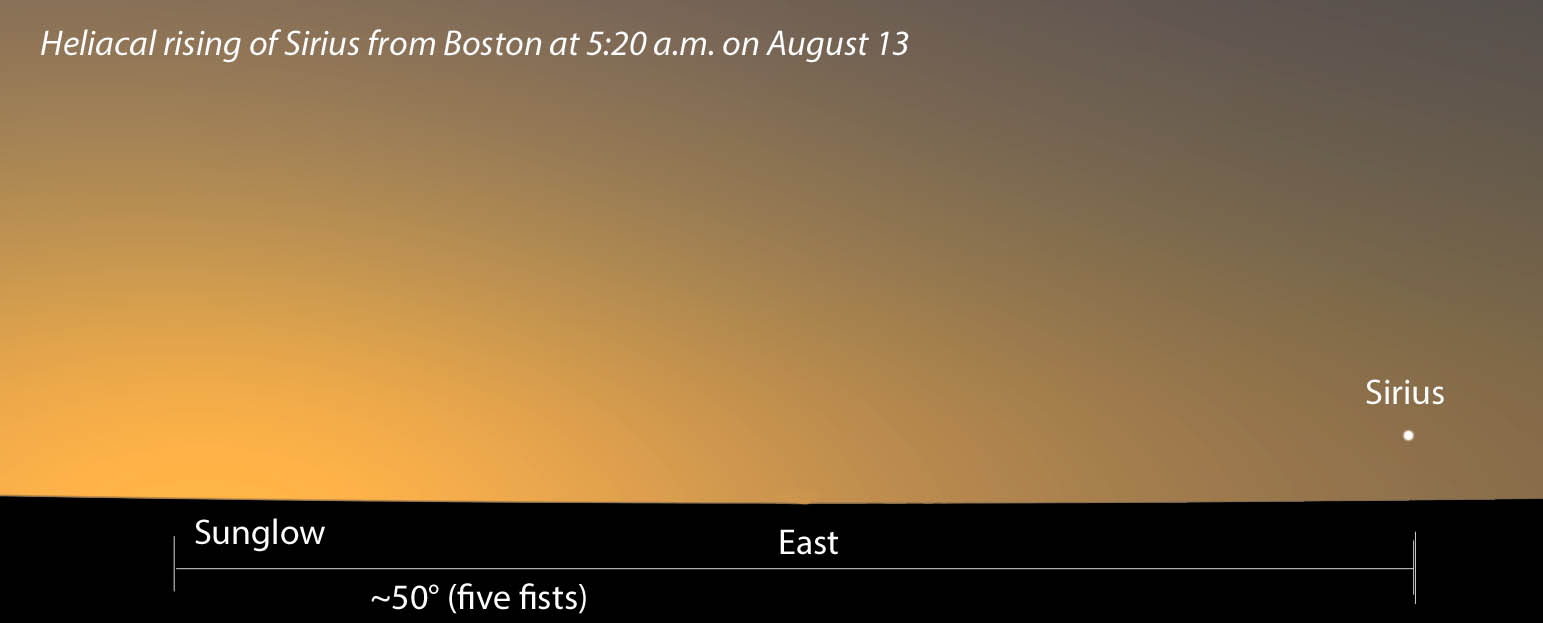Make a connection to a time when stars were used to track seasons and predict natural events by watching the heliacal rising of Sirius.

Jeff Dahl / Wikimedia Commons / CC BY-SA 4.0
Heat, humidity, the searing Sun. Must be the Dog Days of summer. This hottest time of year runs from mid-July to mid-August in the northern hemisphere. Despite the image of dogs sleeping off the heat during endless afternoons, the canine association has naught to do with pups and all to do with the heliacal rising of the star Sirius.
Sirius marks the nose of Canis Major, the Greater Dog. That much I'll concede. In ancient Egypt circa 3000 BC, the star's return at dawn after its ~70 day hiatus in the daytime sky coincided with the flooding of the Nile River, the lifeline of Egypt then as today. Floods deposited precious silt that fertilized the farmlands along the river. Since 1970, when the Aswan Dam was completed, floodwaters are now stored for later release.
The first sighting of Sirius and its association with the rebirth of the Nile was so important that its heliacal rising marked the start of the Egyptian calendar year. Heliacal relates to the star's proximity to the Sun (Helios in Greek). At the time, Sirius made its first appearance in early July as seen from the ancient capital of Memphis, but due to the precession of the equinoxes, the star now rises into view in early August.
Our association of the star with the Dog Days comes from the ancient Greeks who, just like us, were impressed with the star's great brightness. At magnitude –1.46, it's almost twice as bright as the next brightest, Canopus. They called it Seirios, Greek for "sparking" (referring to its near-constant twinkling), "fiery," or "scorching," and associated its heliacal rising with hot weather common in the Mediterranean region during late summer.
Ancient Greeks blamed Sirius in part for the intensity of the summer heat because they believed its fiery, scorching nature added to that of the Sun. After all, the two stars rose at nearly the same time and occupied the same quadrant of the sky in summer.

Stellarium
"Dog Days" translates directly from what your average Roman would have said while mopping sweat from his brow: "Dies caniculariae iterum!" or "The canicular (dog) days again!" Romans believed the heat made dogs rabid. Mine just slinks from the Sun and sleeps in a cool cavity in the earth she excavated behind the kennel.

Bob King
Witnessing the heliacal rising of Sirius depends upon several variables: latitude (tropical latitudes favored due to Sirius's southern declination), atmospheric transparency, and something called the arc of visibility or "arcus visionis." The arc of visibility is the difference in altitude between the star and the Sun at the moment when the star is observed at the horizon without consideration for refraction. For Sirius, the arc comes to 9°-10°. Assuming transparent skies and a minimum altitude of about 2°-3° for sighting Sirius, the heliacal rising of the star would occur with the Sun about 7° below the horizon.
For current day Cairo at latitude +30° N, this occurs on the morning of August 3rd. Under exceptional skies, you might catch sight of the star at 2° altitude, shifting the date of first sighting to August 2nd. Since stars rise four minutes earlier and climb approximately 1° higher with each passing day, Sirius quickly becomes more accessible after its heliacal rising.
The further north you go, the farther Sirius slides to the south and the longer observers have to wait to see their own personal heliacal rising of the star. Like to give it a try? Much of Europe, the U.S., Canada, and Asia still await the Dog Star's appearance at dawn. I plan an outing on the 17th when the star rises for my latitude.
To find out when Sirius eases over the horizon at your house, look up your latitude and then use the table below to get the heliacal rise date. A perfect horizon isn't required, but you'll obviously need to dig way down in the southeastern sky. Plan to be out about 45 minutes before your local sunrise.

Map: Bob King; Source: Stellarium
While the first sighting of Sirius may not signify anything as momentous as the annual flooding of the Nile, seeing it tenderly twinkling at dawn can take us back in time to when it was commonplace for people to use stars to mark important events in their lives. How far we've strayed.
| Latitude north | Approximate date of heliacal rising |
| 32° | August 3 |
| 33° | August 4 |
| 34° | August 5 |
| 35° | August 6 |
| 36° | August 7 |
| 37° | August 8 |
| 38° | August 9 |
| 39° | August 10 |
| 40° | August 11 |
| 41° | August 12 |
| 42° | August 13 |
| 43° | August 14 |
| 44° | August 15 |
| 45° | August 16 |
| 46° | August 17 |
| 47° | August 18 |
| 48° | August 19 |
| 49° | August 20 |
| 50° | August 21 |
* I want to thank Sky & Telescope's David Dickinson and Ed Kotapish for the data used in the table above.
 27
27









Comments
August 10, 2016 at 11:16 am
Hello
wonderfull article, thanks so much for sharing,
well done, and cleary explained,
thanks a lot
@jcfortea
You must be logged in to post a comment.
Bob KingPost Author
August 10, 2016 at 3:34 pm
Thanks Joan -- and good luck on your own sighting.
You must be logged in to post a comment.
Joe Stieber
August 10, 2016 at 12:09 pm
Bob -- you don't specifically mention it, but I presume you're referring to sighting with unaided eyes. I've been looking for Sirius near sunrise for five years now, but I use my trusty 16x70 binoculars (in large measure because I have them on a nice mount). I also travel to a site a few miles from my home, which has a really low eastern horizon, quite unlike my front yard. Regardless, clouds along the horizon seem to be a chronic problem. Anyway, with an unusual clear sky, I had my first sighting of Sirius last week, on August 4, 2016 (which is my earliest date so far). For this location, a couple of miles from 40°N/75°W in NJ, Sirius rose at 5:48 am EDT, the sun rose at 6:02 am and I spotted Sirius at 6:03 am when it was just over 2° altitude. As the dimmed orange sun emerged from behind distant trees at 6:10 am, for a couple of minutes when I backed away from the eyepieces a little, I could simultaneously see the sun in the corner of my left eye while I was seeing Venus in the binoculars.
You must be logged in to post a comment.
Bob KingPost Author
August 10, 2016 at 3:33 pm
Great report on the sighting, Joe! Thanks for sharing it. Yes, I was referring to naked eye sighting but of course there's nothing wrong with binoculars, too. Definitely gives you an edge over the old Egyptian way.
You must be logged in to post a comment.
Anthony Barreiro
August 10, 2016 at 5:17 pm
Joe, you are the greatest living master of seeing planets and bright stars very low above the horizon very close to sunrise and sunset. You inspire me to keep trying, although I will never come close to your achievements.
You must be logged in to post a comment.
Joe Stieber
August 14, 2016 at 4:28 am
Anthony -- Thanks for the compliment, but I'm sure there are a number of observers out there who are just as good, if not better than me at this sort of observing (they probably don't babble on about it as much as I do ). BTW, I was out again on Saturday morning, August 13, 2016, and got my first naked-eye sighting of Sirius at 5:38 am EDT (sunrise was at 6:10 am). This was my first attempt since the initial sighting on August 4 with 16x70 binoculars, and I'm sure I could have seen it at least a couple of days sooner had I tried (and the weather cooperated). I even got a snapshot of Sirius, it's at http://sjastro.org/ (scroll down).
You must be logged in to post a comment.
August 11, 2016 at 1:34 pm
Joe! Did you also capture Venus in the morning hours? Best regards ! Jakob
You must be logged in to post a comment.
Joe Stieber
August 14, 2016 at 4:49 am
Jakob -- Venus is currently in the evening sky, setting less than an hour after the sun, and is converging on Jupiter, with which it will have a very close appulse (less than 4 arc minutes separation) on August 27, 2016. Because it's so bright, I suppose Venus could be observed in the morning, but since it rises about 1.5 hours after the sun, it would be in the daytime sky and poorly positioned under the sun. Recently, I've been spotting Venus in the evening, shortly before or soon after sunset, since June 25, 2016.
You must be logged in to post a comment.
Joe Stieber
August 16, 2016 at 5:12 pm
Oops! I've been alerted to a mental typo in my initial post. In the final sentence, I said I saw the sun and Venus simultaneously on the 4th. It should, of course, have been the sun and Sirius. Thanks to Jakob for pointing it out, and my apologies for not noticing it when he first asked about Venus in the morning.
You must be logged in to post a comment.
Bob
August 10, 2016 at 1:35 pm
Great article. I love to read about archaeo-astronomy.
And Joe, I also love binocular observing.
You must be logged in to post a comment.
Bob KingPost Author
August 10, 2016 at 3:34 pm
Thanks Bob-P! I appreciate you writing to say so.
You must be logged in to post a comment.
Anthony Barreiro
August 10, 2016 at 5:14 pm
Thanks very much, Bob. Coincidentally, this morning, August 9, was the first time in a couple of weeks that San Francisco wasn't completely fogged in at sunrise. It was a bit surprising to see Orion well above the horizon and the Pleiades so far overhead I had to crane my stiff neck back to see them in binoculars. I looked for Sirius, but I hadn't gotten up early enough to hike up Bernal Hill, so no luck, but I'll keep looking.
By the way, your image of Sirius' rising on July 15, 3000 BCE is an obvious hoax. The first pyramids weren't built until after 2700 BCE, and the great pyramid at Giza wasn't completed until around 2560 BCE. I bet you got some help from the guys at NASA who made the "Moon landing" movies. 😉
And there is a slight ambiguity in your second paragraph. The Nile River remains Egypt's lifeline, but the floods stopped after the Aswan High Dam was completed in 1970.
You must be logged in to post a comment.
Bob KingPost Author
August 10, 2016 at 5:35 pm
Anthony,
Those pyramids were obviously built by ancient aliens! You know, you reminded me about the Dam. I actually meant to include that but it slipped my mind on the final edit, so I'm going to add that back. Thanks again!
You must be logged in to post a comment.
Anthony Barreiro
August 11, 2016 at 2:47 pm
I like the edit regarding the Aswan Dam. I'm still a bit bothered by the picture with pyramids that hadn't been built yet. The aliens didn't arrive for several more centuries!
You must be logged in to post a comment.
Neil
July 25, 2017 at 8:28 pm
From the high desert at 35 degrees north, I was able to see Sirius rising on August 7th visually, but that was between two bands of smoke. I could probably have seen it earlier if the smoke hadn't been even worse on the preceding days. At that azimuth there is a low pass through the hills and with the anomalous refraction you can get in the desert at sunrise and sunset, I can see below the horizon. So far this year there isn't any smoke out that way so I'm hoping to see just how early it will be visible.
You must be logged in to post a comment.
Bob KingPost Author
July 26, 2017 at 9:29 am
Hi Neil,
Smoke has been a serious problem even here in the Midwest. I wish you clear, smokeless skies for your observation!
You must be logged in to post a comment.
Mohamed ali
August 15, 2017 at 11:40 pm
Hi Neil,
Mohamed greeting from Egypt, l have been observing Sirius in Egypt, and actually my first observation visually with naked eyes was on 7th of August at altitude of 55 meters above sea level, and I have an inquiry, if you could tell me at what height did you watch the Sirius on the 7th of august, because you have mentioned that you have watched it from a high desert...and thanks for your help....
You must be logged in to post a comment.
Divineharmony
August 9, 2022 at 7:12 am
hi mohamed ~ i hope you get this comment ! i would love to speak with you as i have another egyptian friend in egypt who said earliest he could see it was 8/8. i know the calculations and projections need to be verified with actual visual observance and would love to connect with you via email? my email is [email protected]. thank you !
You must be logged in to post a comment.
Ndimila
October 21, 2017 at 11:51 am
Hi! Bob King and others,
For you in the Northern Hemisphere the Sirius will be seen in the East at heliacal rising, right. What about the heliacal rising of the same star in the Southern Hemisphere? Will this star be seen in the West?
Regards
Ndimila
You must be logged in to post a comment.
Bob KingPost Author
October 23, 2017 at 12:38 am
Dear Ndimila,
Sirius always rises in the southeast no matter which hemisphere.
You must be logged in to post a comment.
Ndimila
October 27, 2017 at 12:59 pm
Dear Bob King,
Thank you for that info. And, there is another testimony coming from New Zealand confirming a dawn heliacal rising of the Matariki (the Pleiades) buttressing your point at: https://www.mch.govt.nz/nz-identity-heritage/matariki
What about the dependence of the rising on latitudes? (N / S)? Should I take the same answer? What about the rising at 66.5°? I would assume that point to be the highest to mean that Sirius will be visible round the year. What about the rising at beyond 66.5°?
Regards
Ndimila
You must be logged in to post a comment.
Divineharmony
August 8, 2021 at 3:28 pm
hi there- thank you for your article. i study the heliacal rise of stars for mythology and astroarchaeology. my understanding is sirius rises in giza egypt today 8/8 not 8/2 or 8/3?
have you seen this software to calculate heliacal rise? http://www.culturediff.org/english/clientarea/softtest14.php
curious your thoughts?
thank you
~h
You must be logged in to post a comment.
Bob KingPost Author
August 8, 2021 at 8:08 pm
Dear H.,
You're very welcome. I still get August 3 for current-day Giza assuming an arc of visibility of 9.5°. I went to the website but it requires some sort of sign-in. Certainly, there's some subjectivity in this arc given sky conditions and skill in sighting. It would definitely be easier on Aug. 8.
You must be logged in to post a comment.
Divineharmony
August 9, 2021 at 10:27 am
hi bob- to access the software for heliacal rise today you just put in your email address and password 'softests' and you get free access. if you want to search previous years or future ones you have to get the software access which is about $20-30 i think but the free one for today will work if you do the above.
if you see above in 2017 a mohammed commented from egypt and said the soonest he saw sirius was 8/7. the software at link above was created by a researcher with a PhD in astronomy.
i have friends in egypt who also only see it on 8/8 so just trying to discern what you are basing your observation on? have you been to egypt and seen it yourself on 8/3?
thank you!
You must be logged in to post a comment.
Divineharmony
August 11, 2021 at 12:03 pm
hi bob- i reached out to the software developer to ask her thoughts about your date given versus what her software says. this was her response:
"The result (day of heliacal rising of Sirius) depends upon the method used - the method based upon the Arcus Visionis is quite old - it dates as far back as the Greek era. The Culture Diff' software is rather recent and based upon contemporary algorithm. In any case, only the observation with the naked eye counts. That means that, whatever is the method you use, the results it leads to must be in accordance with the observation. Given the magnitude of the star, the latitude of the site chosen for observation, the epoch considered, the only parameter you can play with is the visual acuity of the observer - the so-called Snellen Ratio. Its value lies between 0.1 and 2.0. The old Egyptian stargazers were chosen for their great visual acuity - between 1.7 and 1.8. But this value depends upon your age. It slowly decreases as you get older.
There is another parameter to take into account : the atmospherical pollution. No doubt there are more aerosols in the atmosphere today than there was 4000 years ago. As a consequence, you see Sirius rising at an higher altitude than before."
You must be logged in to post a comment.
Divineharmony
August 9, 2022 at 7:10 am
hi bob ~ just wanted to follow up on my comment from last year. i would love to know your thoughts on what the creator of that software had to say and also comments on the comment from mohammed above who is actually in egypt and saw it earliest 8/7. based on the software i linked above they have it going back and forth between 8/7 and 8/8 for the 20th century and in 21st century it is 8/8. seems to be more aligned with what mohammed in egypt is saying. i will say i want to BE THERE in egypt to see it with my own eyes and will plan a trip accordingly 🙂
You must be logged in to post a comment.
neilparker62
November 29, 2021 at 11:35 am
Re: https://www.scirp.org/journal/paperinformation.aspx?paperid=79265
Is there a basic mathematical relationship between the period of heliacal rising of Sirius and that of the lunar period? The gist of the above article appears to be that these numbers appear to be behind the the particular selection of slope angle for the Great Pyramid. Giving rise to apothem (slant height) and half base being in ratio 1.61803:1 (golden ratio).
You must be logged in to post a comment.
You must be logged in to post a comment.